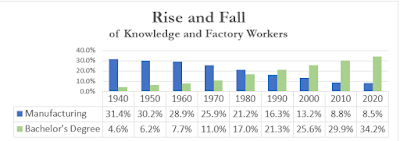In 1972, the Democratic National Committee (DNC) set quotas for women, minorities and students. Curiously, the party that had championed labor since before FDR, did not set quotas for representation from blue-collar or factory workers. To a degree, they turned their back on this group that Democrats had so surely represented for so many decades.
Instead of focusing on blue-collar workers, they shifted their attention to white-collar workers, the new crop of employees who created and used computers and other seemingly esoteric products.
The DNC shifting their attention from blue-collar workers in the industrial economy to white-collar workers in the information economy made for visionary policy and disastrous politics.
In the five presidential elections from 1972 to 1988, Republicans won four by an average of 11.2 million votes. Democrats won only once by 1.7 million, and that was in the wake of Watergate, the worst presidential scandal in more than a century.
If you look at this graph, you can see that in 1970, manufacturing workers were 26% of the workforce. By contrast, college graduates were just 11%. If all you knew is that Republicans had a coalition that focused on factory workers and Democrats focused on knowledge workers and that factory workers outnumbered knowledge workers by more than 2 to 1, you would predict a huge victory for Republicans. And that is, indeed, what happened. In 1972, Nixon won by nearly 18 million votes. It was a landslide. In 1976, after Watergate, Carter won as a Democrat but in 1980, 1984, and 1988, Republicans won the White House.
In the five presidential elections between 1972 and 1988, Republicans won four by an average of 11.2 million votes and Democrats won one by 1.7 million.
By 1992, though, knowledge workers eclipsed factory workers. From then on, Democrats have convincingly won the popular vote.
 In the seven presidential elections since 1992, Democrats have won four elections by an average of 7.1 million votes. Republicans have won three elections by an average of -133,444 votes. (Yep. That number is negative.) In those seven elections, Republicans won the popular vote only once and - like the 1976 election after Watergate - the 2004 election was in the wake of 9-11 and the invasion of Iraq. That is to say, like 1976, in 2004 voters thought something else mattered more than their economic interests.
In the seven presidential elections since 1992, Democrats have won four elections by an average of 7.1 million votes. Republicans have won three elections by an average of -133,444 votes. (Yep. That number is negative.) In those seven elections, Republicans won the popular vote only once and - like the 1976 election after Watergate - the 2004 election was in the wake of 9-11 and the invasion of Iraq. That is to say, like 1976, in 2004 voters thought something else mattered more than their economic interests.
From a policy perspective - a question of what policies will create the most jobs and wealth - we had easily moved into an information economy by 1972. From a political perspective - a question of what will get you elected - we had moved into an information economy by 1992.
I'm confident that Trump will not win the popular vote in 2020. I'm doubtful that he will again win the electoral vote. Too many urban residents who identify with and are a part of the global, diverse information economy dependent on knowledge workers will vote against him and not enough rural residents who identify with and are part of the national, industrial economy dependent on capital and factory workers will vote for him.

No comments:
Post a Comment